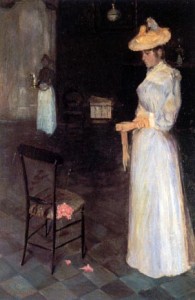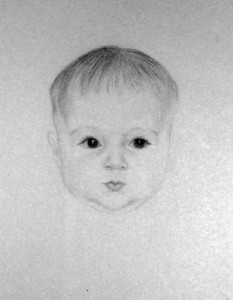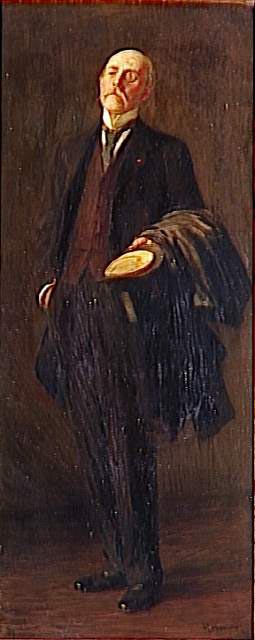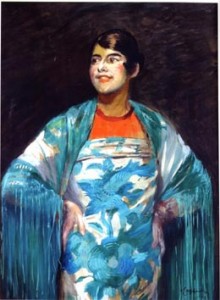Portraits
Cappiello became passionate about painting from a very young age. He learned to paint on his own, without a teacher. In the beginning, he was influenced by macchiaioli painters because of acquaintances he had made.
His first known paintings date back to 1886. He was only 11 years old.
These were mainly portraits, often featuring landscapes or interior décor in the background (cf. opposite painting), and also some paintings of landscapes exclusively.
Very quickly his predilection turns towards portrait art, or rather towards its more synthetic form: caricature. He practices this genre for about 8 years. From 1904, he stops drawing caricatures. However many celebrities keep asking him to paint their portrait, particularly during the 1905-1920 period.
Despite the fact that many are wonderful, they are not well known because most of them have barely been exhibited and stay within the families of the people he painted. They have moreover probably been smothered by the exceptional collection of caricatures and posters by Cappiello.
Besides his self-portraits and portraits of his wife and children, we will mention as examples, the portraits of his sister-in-law Jeanne Mühlfeld, those of his brother-in-law Paul Adam, of Puccini, of Mrs. Jean Stern, and of Princess Magda Achille Murat dressed up in a Thai dancer costume.
In his portraits, Cappiello looks not only for physical, but also psychological likeness, and with a scrupulous accuracy too. They key to his art is simplification. He tells us: ‘In a face, there are a few features which need to be captured, conserved, all others must disappear. The real reflective work is isolating them.’
It is Cappiello’s command of the lines he draws which allows him to reveal the character of the model he paints. He no longer needs to present them in their own world to give them life as he did in his first paintings. We see here the qualities of the caricaturist, but also those of the poster artist: he creates life through movement.
The portrait of Henri Régnier, painted in 1909, is particularly interesting in that respect.
G. Apollinaire, in an article published in L’Intransigeant on April 3rd 1910, writes:
‘Room III ter. Leonetto Cappiello exhibits a very resembling portrait of Henri de Régnier… His face with his drooping mustache has this disdainful and dreamy expression which gives the impression to those who recognize the author of ‘La Sandale Ailée’ (‘The Winged Sandal’) that his body is present but that his mind is elsewhere.’
Another example is ‘The Young Spanish Woman’ below. Although she looks like she has a firm stand with her hands on her hips, she draws us towards the left of the painting with her vivid gaze.
Despite all the qualities of his paintings, it is mainly through caricature, then through poster art that Cappiello imposes his innovative art.





